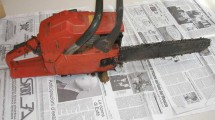Abstract
A 41-year-old man was found by his wife in an atypical hanging situation in their apartment. As there was a known previous psychiatric illness and a history of suicide attempts, the investigative authorities assumed this case was a suicide. However, the autopsy revealed numerous findings that are unusual for a suicidal atypical hanging, including numerous cuts on the face, the arms and the penis. According to his wife, the deceased suffered from Asperger's syndrome with auto-aggressive behavior. He had allegedly injured himself with household scissors in the days before his death and had hit himself numerous times in the face the night before his death. His wife also revealed that she would injure him with scissors at his request. Even though the observed injury pattern in this case contradicted a self-infliction, the information given by the wife about the chronology of the occurrence of injuries could be reconciled with the findings of the immunohistochemical estimation of wound age. The circumstances that led to the hanging remained unresolved.







Similar content being viewed by others
References
Osuch E, Noll J, Putnam F. The motivation for self-injury in psychiatric inpatients. Psychiatry. 1999;62:334–6. https://doi.org/10.1080/00332747.1999.11024881.
Nitkowski D, Petermann F. Non-suicidal self-injury and comorbid mental disorders: a review. Fortschr Neurol Psychiat. 2011;79:9–20. https://doi.org/10.1055/s-0029-1245772.
Bohus M, Schmahl C. Psychopathology and treatment of borderline personality disorders. Nervenarzt. 2007;78:1069–81. https://doi.org/10.1007/s00115-007-2341-x.
Biskin R, Paris J. Diagnosing borderline personalitiy disorder. CMAJ. 2012;184:1789–94. https://doi.org/10.1503/cmaj.090618.
Pollak S. Verletzung durch eigene oder fremde Hand. In: Brinkmann B, Madea B, editors. Handbuch gerichtliche Medizin. Berlin, Heidelberg, New York, Tokio: Springer; 2004. p. 250–7.
Petermann F, Winkel S. Selbstverletzendes verhalten. diagnostische und psychotherapeutische ansätze. Zeitschrift für Psychiatrie, Psychologie und Psychotherapie. 2007;55:123–33. https://doi.org/10.1024/1661-4747.55.2.123.
Fliege H, Kocalevent R, Walter O, Beck S, Gratz K, Gutierrez P, et al. Three assessment tools for deliberate self-harm and sucide behaviour: evaluation and psychopathological correlates. J Psychosom Res. 2006;61:113–21. https://doi.org/10.1016/j.jpsychores.2005.10.006.
Ishida Y, Kuninaka Y, Nosaka M, Shimada E, et al. Forensic application of epidermal AQP3 expression to determination of wound vitality in human compressed neck skin. Int J Leg Med. 2018;132:1375–80. https://doi.org/10.1007/s00414-018-1780-1.
Kubo H, et al. Forensic diagnosis of ante- and postmortem burn based on aquaporin-3 gene expression in the skin. Leg Med. 2014;16:128–34. https://doi.org/10.1016/j.legalmed.2014.01.008.
Madea B, Doberentz E, Jackowski C. Vital reactions – An updated overview. Forensic Sci Int. 2019;305:110029. https://doi.org/10.1016/j.forsciint.2019.110029.
Betz P. Histologische kriterien zur altersschätzung menschlicher hautwunden. Rechtsmed. 1999;9:163–9. https://doi.org/10.1007/s001940050103.
Matsumoto T, Azekawa T, Yamaguchi A, Asami T, Iseki E. Habitual self-mutilitation in Japan. Psychiatry Clin Neurosci. 2004;58:191–8. https://doi.org/10.1111/j.14401819.2003.01216.x.
Matsumoto T, Yamaguchi A, Chiba Y, Asami T, Iseki E, Hirayasu Y. Patterns of self-cutting: A preliminary study on differences in clinical implications between wrist- and arm-cutting using a Japanese juvenile detention center sample. Psychiatry Clin Neurosci. 2004;58:377–82. https://doi.org/10.1111/j.1440-1819.2004.01271.x.
Töro K, Pollak S. Complex suicide versus complicated suicide. Forensic Sci Int. 2009;184:6–9. https://doi.org/10.1016/j.forsciint.2008.10.020.
Du Chesne A, Brinkmann B. Autoerotische unfälle. In: Brinkmann B, Madea B, editors. Handbuch gerichtliche Medizin, vol. 1. Berlin, Heidelberg, New York, Tokio: Springer; 2004. p. 794–6.
Briere J, Gil E. Self-mutilitation in clinical and general population samples: prevalence, correlates and functions. Am J Orthopsychiatry. 1998;68:609–20. https://doi.org/10.1037/h0080369.
Nixon MK, Cloutier PF, Aggarwal S. Affect regulation and addictive aspects of repetitive self-injury in hospitalized adolescents. J Am Acad Child Adolesc Psychiatry. 2002;41:1333–41. https://doi.org/10.1097/00004583-200211000-00015.
Klonski ED. The functions of deliberate self-injury: A review of the evidence. Clin Psychol Rev. 2007;27:226–39. https://doi.org/10.1016/j.cpr.2006.08.002.
Paquette-Smith M, Weiss J, Lunsky Y. History of suicide attempts in adults with asperger syndrome. Crisis. 2014;35:273–7. https://doi.org/10.1027/0227-5910/a000263.
Takara K, Kondo T. Comorbid atypical autistic traits as a potential risk factor for suicide attempts among adult depressed patients: a case-control study. Ann Gen Psychiatry. 2014;13:33. https://doi.org/10.1186/s12991-014-0033-z.
Statistisches Bundesamt. http://www.gbe-bund.de/oowa921-install/servlet/oowa/aw92/dboowasys921.xwdevkit/xwd_init?gbe.isgbetol/xs_start_neu/&p_aid=i&p_aid=46319629&nummer=6&p_sprache=D&p_indsp=7062&p_aid=73792279. Accessed 21 Oct 2020.
WHO. https://www.who.int/healthinfo/mortality_data/en/. Accessed 09 Apr 2020.
Arsenault-Lapierre G, Kim C, Turecki G. Psychiatric diagnoses in 3275 suicides: a meta-analysis. BMC Psychiatry. 2004;4:37. https://doi.org/10.1186/1471-244X-4-37.
Asukai N. Suicide and mental disorders. Psychiatry Clin Neurosci. 1995;49:91–7. https://doi.org/10.1111/j.1440-1819.1995.tb01926.x.
Byard RW. Suizidales erhängen mit anogenitalen mutilitationen Rechtsmed. 2012;22:187–9. https://doi.org/10.1007/s00194-012-0826-9.
Austin AE, Guddat SS, Tsokos M, Gilbert JD, Byard RW. Multiple injuries in suicide simulating homicide: report of three cases. J Forensic Leg Med. 2013;20:601–4. https://doi.org/10.1016/j.jflm.2013.02.005.
Madea B. Homicidal versus suicidal penis amputation. A contribution to the problem of missing and conflicting stains. Arch Kriminol. 1995;196:70–7.
Banaschack S, Madea B. Selbstbeschädigung. In: Madea B, editor. Praxis der Rechtsmedizin. Berlin, Heidelberg, New York: Springer; 2003. p. 268–73.
Funding
This research did not receive any specific grant from funding agencies in the public, commercial, or not-for-profit sectors.
Author information
Authors and Affiliations
Corresponding author
Ethics declarations
Conflict of interest
The corresponding author declares also on behalf of her co-authors there is no conflict of interest.
Informed Consent
Consent to participate and consent for publication were not applicable.
Research involving human and animal participants
This article does not contain any studies with human participants or animals.
Additional information
Publisher’s Note
Springer Nature remains neutral with regard to jurisdictional claims in published maps and institutional affiliations.
Rights and permissions
About this article
Cite this article
Duval, I., Doberentz, E. & Madea, B. Unusual (self-)injuries in a case of hanging. Forensic Sci Med Pathol 17, 354–361 (2021). https://doi.org/10.1007/s12024-020-00346-w
Accepted:
Published:
Issue Date:
DOI: https://doi.org/10.1007/s12024-020-00346-w




